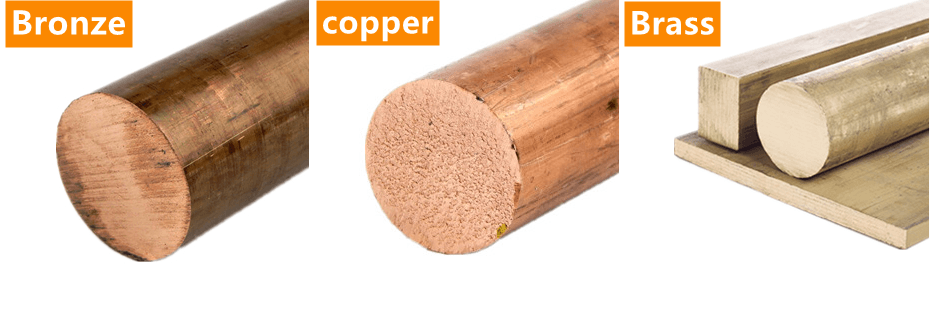Copper, Brass and Bronze overview
Copper, brass, and bronze are all metal alloys. Commonly used in a variety of applications, including construction, manufacturing, and decorative arts.
Copper is a soft, reddish-brown metal that is known for its excellent electrical conductivity.
Brass is an alloy of copper and zinc, and it is known for its yellow color and durability.
Bronze is an alloy of copper and tin, and it is known for its strength and corrosion resistance.

All three alloys have similar properties. They are used in different applications due to their unique characteristics.
Copper
Copper is a versatile metal. Known for its excellent electrical, and thermal conductivity, strength, formability, and resistance to corrosion. These properties make it a popular choice for the manufacture of products. Such as pipes and pipe fittings, which are used in construction and plumbing due to their corrosion resistance. Copper can also be soldered, brazed, and welded, allowing for a wide range of fabrication possibilities.
Copper can be polished and buffed to achieve the desired texture and shine. There are different grades of unalloyed copper, which vary in the number of impurities present. Oxygen-free copper is used in applications where high conductivity and ductility are required.
Additionally, copper has been found to have antimicrobial properties. As it was found to kill over 99.9% of bacteria within two hours of contact according to the Environmental Protection Agency. The effectiveness of copper’s antimicrobial properties is not affected by tarnishing.
Copper Applications
Copper is an early discovered metal that has been used by the Greeks, Romans, and others for tools and decorations. It has also been used for wound sterilization and water purification. Today, it is mostly used in electrical materials like wiring because of its conductive properties.
Brass
Brass is an alloy made up of mostly copper and zinc. It has a yellow-gold color and is known for being durable and resistant to corrosion. Because of these properties, it is often used in things like musical instruments, locks, and doorknobs. In addition, it is also commonly used in the construction of buildings, as well as in various art forms such as sculptures and jewelry. Due to its unique look, it is also a popular choice for decorative items such as candlesticks and vases.
Examples of a mixture of brass are the following:
- Red Brass
It is made by adding around 5-15% of tin to the traditional brass alloy (Copper-Zinc). This creates a brass that has a reddish color and is more resistant to corrosion. It is often used in plumbing, in the production of valves, fittings and other water-related equipment. Because of its higher resistance to corrosion and its ability to resist dezincification.
- Muntz metal
It’s made by adding around 60% of zinc to the brass alloy. This creates a brass that is harder, stronger and more durable than traditional brass. It is often used in marine hardware and other applications where strength and resistance to corrosion are important.
Brass Applications
Brass is a versatile metal alloy composed primarily of copper and zinc. Its properties make it a popular choice for a wide variety of applications. One common use of brass is in plumbing fixtures and fittings, where it is known for its durability and resistance to water damage. Another popular use is in musical instruments, where its bright, warm tone is highly prized.
Additionally, because of its good conductivity, brass is often used in electrical applications. Other industrial applications of brass include gears, valves, and bearings. Furthermore, brass is also widely used in decorative items and ornamental items. Such as sculptures, statues, and home decor items.
Brass Alloys
Brass alloys are metal alloys made primarily of copper and zinc. With the addition of other elements such as aluminum, lead, tin, manganese, and iron. These elements can change the properties of the alloy like increasing of strength and corrosion resistance. Different brass alloys are formulated to suit specific applications.
For example, an alloy that contains a higher percentage of zinc will be stronger and harder than one with a lower percentage. Thus making it more suitable for applications that need high strength and wear resistance.
An alloy that contains a higher percentage of copper will have better corrosion resistance than one with a lower percentage. Making it more suitable for applications that must those properties.
Common brass alloys include:
- C26000 Cartridge Brass
- C36000 Free-Cutting Brass
- C38500 Leaded Brass
- C46400 Naval Brass
Bronze
Bronze is a metal alloy that is made of copper, with the addition of other elements such as tin, aluminum, manganese, and silicon. These extra elements can change the properties of the alloy. Such as increasing its strength, hardness, and corrosion resistance. It is durable and resistance to wear, making it a popular choice for a wide variety of applications.
Bronze Application
Bronze is used in a wide variety of applications due to its durability and resistance to wear. Some common uses include:
- Sculpture and art
Bronze is a popular choice among artists due to its warm color and ability to hold fine details. It is used to create sculptures, statues, and other forms of decorative art.
- Bearings and gears
Bronze is often used in industrial applications. Such as bearings and gears because of its strength and resistance to wear.
- Valves
Bronze valves are often used in piping systems. Because of their durability and corrosion resistance.
- Marine Applications
Bronze is also used in marine applications. Such as propellers, ships, and boats because of its resistance to corrosion in salt water.
- Jewelry
Bronze is also used for making different types of jewelry items. Examples are bracelets, necklaces, and earrings.
- Architecture
Bronze is also used in architectural applications. Such as door knobs, handles, and other decorative elements.
- Musical instruments
Bronze is also used in making musical instruments. Like cymbals and bells due to its unique sound and durability.
Types of Bronze Alloys
Bronze alloys can have a wide range of compositions depending on the desired properties and application. Here are a few common bronze alloys and their approximate percentage of elements:
- Phosphor Bronze: Typically composed of 4-11% tin, 0.01-0.35% phosphorous, and the balance being copper. Known for its high electrical conductivity and resistance to corrosion. It is often used in electrical applications such as connectors and switches.
- Aluminum Bronze: Typically composed of 6-12% aluminum, 0.5-3% iron, and the balance being copper. It is known for its high strength and resistance to wear and corrosion. It is often used in applications such as bearings and gears.
- Tin Bronze: Typically composed of 8-12% tin, and the balance being copper. Known for its good machinability and corrosion resistance and is often used in applications such as valves and fittings.
- Leaded Bronze: Typically composed of 8-12% tin and 2-6% lead, and the balance being copper. t is known for its good machinability, good wear resistance and corrosion resistance. It is often used in applications such as bearings and gears.
- Silicon Bronze: Typically composed of 0.5-3% silicon, and the balance being copper. Known for its good corrosion resistance and strength. It is often used in marine applications and also used in making art crafts.
- Manganese Bronze: Typically composed of 1-2% manganese, 0.5-2% zinc and the balance being copper. It is known for its high strength and corrosion resistance. It is often used in applications such as gears and bearings.
JC CASTING: THE MANUFACTURER YOU NEED
At JC Casting, we are experts in producing long-lasting metal castings and forging. These beneficial items may be customized to fit any particular needs. Our engineers are excellent at developing the key components for high-quality casts, and we strive to set a new industry standard. We’re pleased to inform you that all of our goods are created in China. Call us now!
